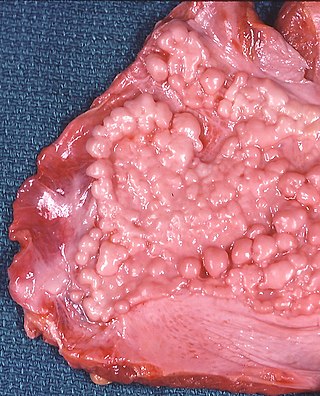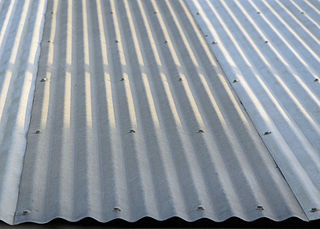Related Research Articles

Mesothelioma is a type of cancer that develops from the thin layer of tissue that covers many of the internal organs. The area most commonly affected is the lining of the lungs and chest wall. Less commonly the lining of the abdomen and rarely the sac surrounding the heart, or the sac surrounding the testis may be affected. Signs and symptoms of mesothelioma may include shortness of breath due to fluid around the lung, a swollen abdomen, chest wall pain, cough, feeling tired, and weight loss. These symptoms typically come on slowly.

Asbestosis is long-term inflammation and scarring of the lungs due to asbestos fibers. Symptoms may include shortness of breath, cough, wheezing, and chest tightness. Complications may include lung cancer, mesothelioma, and pulmonary heart disease.

Silicosis is a form of occupational lung disease caused by inhalation of crystalline silica dust. It is marked by inflammation and scarring in the form of nodular lesions in the upper lobes of the lungs. It is a type of pneumoconiosis. Silicosis is characterized by shortness of breath, cough, fever, and cyanosis. It may often be misdiagnosed as pulmonary edema, pneumonia, or tuberculosis. Using workplace controls, silicosis is almost always a preventable disease.
The mineral asbestos is subject to a wide range of laws and regulations that relate to its production and use, including mining, manufacturing, use and disposal. Injuries attributed to asbestos have resulted in both workers' compensation claims and injury litigation. Health problems attributed to asbestos include asbestosis, mesothelioma, lung cancer, and diffuse pleural thickening.

Respiratory diseases, or lung diseases, are pathological conditions affecting the organs and tissues that make gas exchange difficult in air-breathing animals. They include conditions of the respiratory tract including the trachea, bronchi, bronchioles, alveoli, pleurae, pleural cavity, the nerves and muscles of respiration. Respiratory diseases range from mild and self-limiting, such as the common cold, influenza, and pharyngitis to life-threatening diseases such as bacterial pneumonia, pulmonary embolism, tuberculosis, acute asthma, lung cancer, and severe acute respiratory syndromes, such as COVID-19. Respiratory diseases can be classified in many different ways, including by the organ or tissue involved, by the type and pattern of associated signs and symptoms, or by the cause of the disease.
Occupational lung diseases comprise a broad group of diseases, including occupational asthma, industrial bronchitis, chronic obstructive pulmonary disease (COPD), bronchiolitis obliterans, inhalation injury, interstitial lung diseases, infections, lung cancer and mesothelioma. These can be caused directly or due to immunological response to an exposure to a variety of dusts, chemicals, proteins or organisms. Occupational cases of interstitial lung disease may be misdiagnosed as COPD, idiopathic pulmonary fibrosis, or a myriad of other diseases; leading to a delay in identification of the causative agent.
Pulmonary toxicity is the medical name for side effects on the lungs.
Pleural disease occurs in the pleural space, which is the thin fluid-filled area in between the two pulmonary pleurae in the human body. There are several disorders and complications that can occur within the pleural area, and the surrounding tissues in the lung.

Fibrothorax is a medical condition characterised by severe scarring (fibrosis) and fusion of the layers of the pleural space surrounding the lungs resulting in decreased movement of the lung and ribcage. The main symptom of fibrothorax is shortness of breath. There also may be recurrent fluid collections surrounding the lungs. Fibrothorax may occur as a complication of many diseases, including infection of the pleural space known as an empyema or bleeding into the pleural space known as a haemothorax.

Asbestos is a naturally occurring fibrous silicate mineral. There are six types, all of which are composed of long and thin fibrous crystals, each fibre being composed of many microscopic "fibrils" that can be released into the atmosphere by abrasion and other processes. Inhalation of asbestos fibres can lead to various dangerous lung conditions, including mesothelioma, asbestosis, and lung cancer. As a result of these health effects, asbestos is considered a serious health and safety hazard.

Erionite is a naturally occurring fibrous mineral that belongs to a group of minerals called zeolites. It usually is found in volcanic ash that has been altered by weathering and ground water. Erionite forms brittle, wool-like fibrous masses in the hollows of rock formations and has an internal molecular structure similar to chabazite. Some properties of erionite are similar to the properties of asbestos; however, erionite is not currently regulated by the U.S. Environmental Protection Agency and there are no occupational exposure limits for erionite fibers. Erionite was first described by A.S. Eakle in 1898, as white woolly fibrous masses in cavities in rhyolite lava near Durkee, Oregon. It was originally thought to be another relatively rare zeolite named offretite, which is very similar to erionite in appearance and chemical composition.

Fibre cement is a composite building and construction material, used mainly in roofing and facade products because of its strength and durability. One common use is in fiber cement siding on buildings.
The ILO International Classification of Radiographs of Pneumoconioses is a system of classifying chest radiographs (X-rays) for persons with a form of pneumoconiosis. The intent is to provide a standardized, uniform method of interpreting and describing abnormalities in chest x-rays that are thought to be caused by prolonged dust inhalation. In use, it provides a system for both epidemiological comparisons of many individuals exposed to dust and evaluation of an individual's potential disease relative to established standards.
Raja Michael Flores is an American thoracic surgeon and former candidate for mayor of New York City, currently Chief of the Division of Thoracic Surgery at Mount Sinai Hospital and Ames Professor of Cardiothoracic Surgery at the Icahn School of Medicine at Mount Sinai, both in New York City. On March 20, 2021, Dr. Flores announced his campaign for mayor of NYC.
Nancy Tait, born in Enfield, London was a health and safety activist and campaigner who sought to raise awareness of the health risks associated with exposure to asbestos.
Tumor-like disorders of the lung pleura are a group of conditions that on initial radiological studies might be confused with malignant lesions. Radiologists must be aware of these conditions in order to avoid misdiagnosing patients. Examples of such lesions are: pleural plaques, thoracic splenosis, catamenial pneumothorax, pleural pseudotumor, diffuse pleural thickening, diffuse pulmonary lymphangiomatosis and Erdheim–Chester disease.

Asbestos-related diseases are disorders of the lung and pleura caused by the inhalation of asbestos fibres. Asbestos-related diseases include non-malignant disorders such as asbestosis, diffuse pleural thickening, pleural plaques, pleural effusion, rounded atelectasis and malignancies such as lung cancer and malignant mesothelioma.
Hyperthermic intrathoracic chemotherapy (HITOC) is part of a surgical strategy employed in the treatment of various pleural malignancies. The pleura in this situation could be considered to include the surface linings of the chest wall, lungs, mediastinum, and diaphragm. HITOC is the chest counterpart of HIPEC. Traditionally used in the treatment of malignant mesothelioma, a primary malignancy of the pleura, this modality has recently been evaluated in the treatment of secondary pleural malignancies.

All types of asbestos fibers are known to cause serious health hazards in humans. The most common diseases associated with chronic exposure to asbestos are asbestosis and mesothelioma.
Occupational hazards of fire debris cleanup are the hazards to health and safety of the personnel tasked with clearing the area of debris and combustion products after a conflagration. Once extinguished, fire debris cleanup poses several safety and health risks for workers. Employers responsible for fire debris cleanup and other work in areas damaged or destroyed by fire are generally obliged by occupational safety and health legislation of the relevant national or regional authority to identify and evaluate hazards, correct any unsafe or unhealthy conditions and provide any necessary training and instruction and personal protective equipment to employees to enable them to carry out the task without undue exposure to hazards. Many of the approaches to control risk in occupational settings can be applied to preventing injuries and disease. This type of work can be completed by general construction firms who may not be fully trained specifically for fire safety and on fire hazards.
References
- ↑ Constantopoulos SH, Goudevenos JA, Saratzis NA, Langer AE, Selikoff IJ, Moutsopoulos HM. Metsovo lung: pleural calcifications and restrictive lung function in north-western Greece; environmental exposure to mineral fiber as etiology. Environmental Research, 1985; 38(2): 319-331
- ↑ Constantopoulos SH, Malamou-Mitsi V, Goudevenos JA, Papathanasiou MP, Pavlidis NA, Papadimitriou CS. High incidence of malignant pleural mesothelioma in neighbouring villages of Northwest Greece. Respiration, 1987; 51: 266-271
- ↑ Selikoff IJ, Churg J, Hammond EC. Asbestos exposure and neoplasia. JAMA 1964; 188: 142-146
- 1 2 Dennis J. Darcey and Tony Alleman. Occupational and environmental exposure to asbestos. In: Victor L. Roggli, Tim D. Oury and Thomas A. Sporn (Eds). Pathology of asbestos-associated diseases. 2nd edition, Springer Verlag 1992; p. 17-33
- 1 2 Langer AM, Nolan RP, Constantopoulos SH, Moutsopoulos HM. Association of Metsovo lung and pleural mesothelioma with exposure to tremolite-containing whitewash. Lancet i, 1987; April 25: 965-967
- 1 2 Constantopoulos SH, Langer AM, Saratzis N, Nolan RP. Regional findings in Metsovo lung. Lancet ii, 1987; 452-453
- 1 2 3 Constantopoulos SH. Environmental mesothelioma associated with tremolite asbestos: Lessons from the experiences of Turkey, Greece, Corsica, New Caledonia and Cyprus. Regulatory Toxicology and Pharmacology, 2008; 52: S110-S115
- 1 2 3 Baris YI, Saracci R, Simonato L, Skidmore JW, Artvinli M. Malignant mesothelioma and radiological chest abnormalities in two villages in central Turkey. Lancet 1981; 1: 984-987
- 1 2 Baris ΥΙ, Sahin AA, Ozesmi M, Kerse I, Ozen E, Kolacan B, Altinorrs M, Goktepeli A. An outbreak of pleural mesothelioma and chronic fibrosing pleurisy in the village of Karain/Urug in Anatolia. Thorax 1978; 33: 181-192
- 1 2 3 Constantopoulos SH, Saratzis NA, Goudevenos JA, Kontogiannis D, Karantanas A. Katsiotis P. Tremolite white-washing and pleural calcifications . Chest 1987; 92: 709-712
- ↑ Constantopoulos SH, Theodoracopoulos P, Dascalopoulos G, Saratzis N, Sideris K. Metsovo lung outside Metsovo. Chest, 1991; 99: 1158-61
- ↑ Constantopoulos SH, Dalavanga YA, Sakellariou K, Goudevenos J, Kotoulas OB. Lymphocytic alveolitis and pleural calcifications in non-occupational asbestos exposure. Protection against neoplasia? American Review of Respiratory Diseases, 1992; 146: 1565-1570
- ↑ Hillerdal G. Malignant mesothelioma 198: review of 4.710 published cases. Br J Dis Chest 1983; 77: 321-328
- 1 2 Gogali A, Ntzani E, Peristeri S, Tzarouchi L, Manda-Stachouli C, Vadivoulis Th, Dascalopoulos G, Tsampoulas K, Constantopoulos S, and Dalavanga Y. End of domestic asbestos exposure epidemic in Metsovo; N.W. Greece European Respiratory Society, Annual Congress 2012
- 1 2 Gogali A, Ntzani E, Konstantinidis A, Peristeri S, Tzarouchi L, Manda-Stachouli C, Daskalopoulos G, Constantopoulos SH, Dalavanga YA. Assessment of an isolated environmental and domestic asbestos exposure in Metsovo NW Greece: evidence of containment (Submitted)
- ↑ Manda-Stachouli C, Dalavanga Y, Dascalopoulos G, Leontaridi Ch, Vassiliou M, Constantopoulos SH. Decreasing prevalence of pleural calcifications among Metsovites with non-occupational asbestos exposure. Chest, 2004; 126: 617-621
- ↑ Sakellariou K, Malamou-Mitsi V, Haritou A, Koumpaniou Ch, Stachouli C, Dimoliatis ID, Constantopoulos SH. Malignant pleural mesothelioma from non-occupational asbestos exposure in Metsovo (North West Greece); slow end of an epidemic? Εuropean Respiratory Journal, 1996; 9: 1206-1210
- ↑ Gogali A, Manda-Stachouli C, Ntzani EE, Matthaiou M, Konstantinidis AK, Zampira I, Koubaniou Ch, Dalavanga Y, Stefanou D, Constantopoulos SH and Daskalopoulos G. Malignant mesothelioma in Metsovo, Greece, from domestic use of asbestos: 30 years later. Εuropean Respiratory Journal,2012; 39: 1-2
- ↑ Constantopoulos S. Metsovo lung. A detective story with a happy ending. PNEUMON Supplement 1, Vol 27, 2014